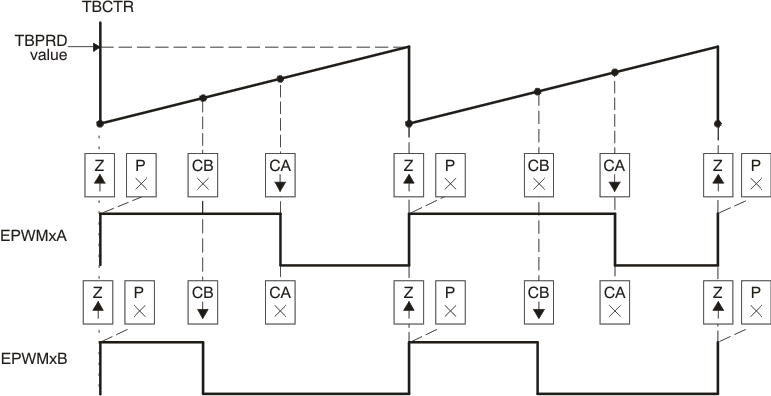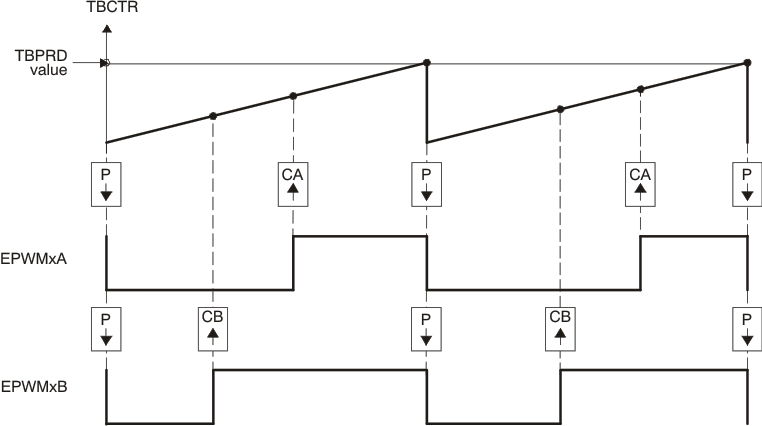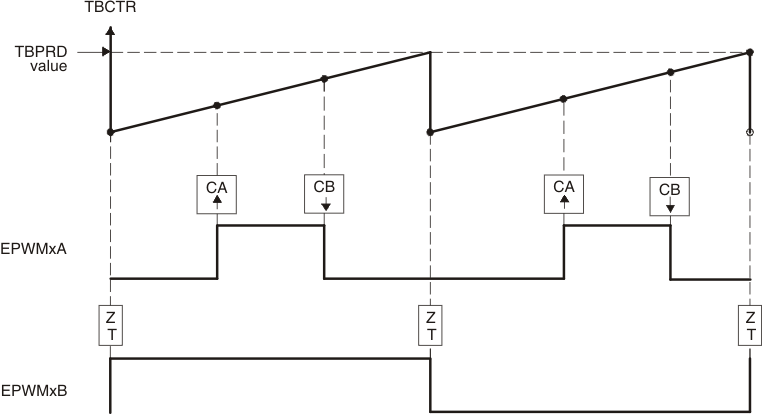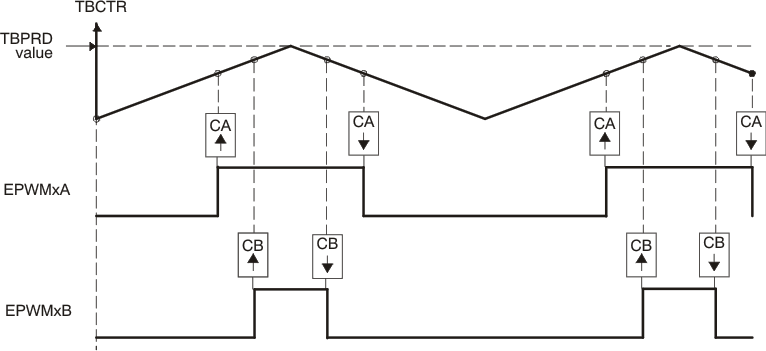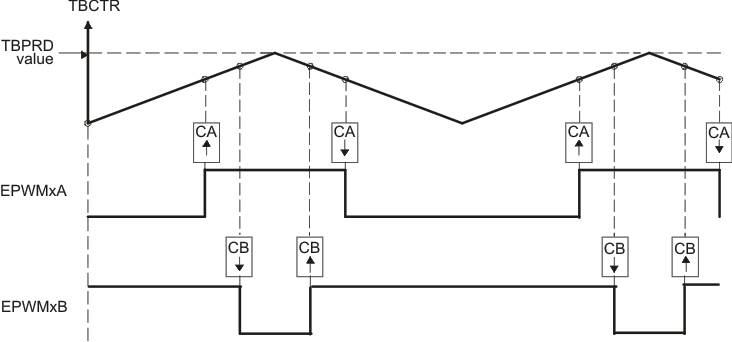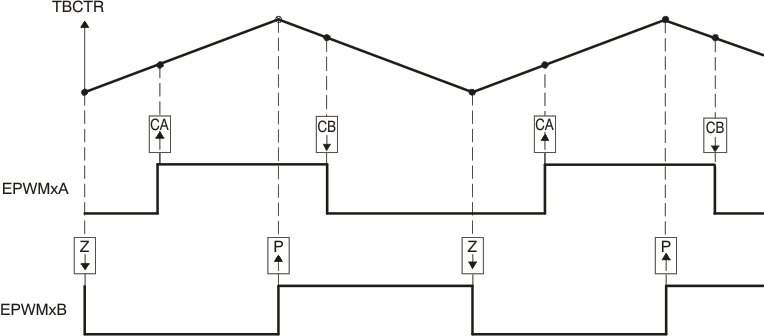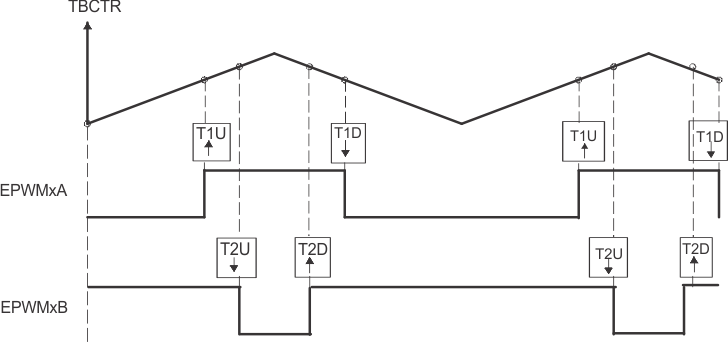SPRUIY4B February 2023 – May 2024 TMS320F2800152-Q1 , TMS320F2800153-Q1 , TMS320F2800154-Q1 , TMS320F2800155 , TMS320F2800155-Q1 , TMS320F2800156-Q1 , TMS320F2800157 , TMS320F2800157-Q1
- 1
- Read This First
- 1 C2000™ Microcontrollers Software Support
- 2 C28x Processor
- 3 Lockstep Compare Module (LCM)
-
4 System Control and
Interrupts
- 4.1 Introduction
- 4.2 Power Management
- 4.3 Device Identification and Configuration Registers
- 4.4
Resets
- 4.4.1 Reset Sources
- 4.4.2 External Reset (XRS)
- 4.4.3 Simulate External Reset (SIMRESET.XRS)
- 4.4.4 Power-On Reset (POR)
- 4.4.5 Brown-Out-Reset (BOR)
- 4.4.6 Debugger Reset (SYSRS)
- 4.4.7 Simulate CPU Reset
- 4.4.8 Watchdog Reset (WDRS)
- 4.4.9 NMI Watchdog Reset (NMIWDRS)
- 4.4.10 DCSM Safe Code Copy Reset (SCCRESET)
- 4.5 Peripheral Interrupts
- 4.6 Exceptions and Non-Maskable Interrupts
- 4.7
Clocking
- 4.7.1 Clock Sources
- 4.7.2 Derived Clocks
- 4.7.3 Device Clock Domains
- 4.7.4 XCLKOUT
- 4.7.5 Clock Connectivity
- 4.7.6 Clock Source and PLL Setup
- 4.7.7 Using an External Crystal or Resonator
- 4.7.8 Using an External Oscillator
- 4.7.9 Using an External Resistor (ExtR) With Internal Oscillator
- 4.7.10 Choosing PLL Settings
- 4.7.11 System Clock Setup
- 4.7.12 SYS PLL Bypass
- 4.7.13 Clock (OSCCLK) Failure Detection
- 4.8 32-Bit CPU Timers 0/1/2
- 4.9 Watchdog Timer
- 4.10 Low-Power Modes
- 4.11 Memory Controller Module
- 4.12 JTAG
- 4.13 System Control Register Configuration Restrictions
- 4.14
Software
- 4.14.1 SYSCTL Examples
- 4.14.2 TIMER Examples
- 4.14.3 MEMCFG Examples
- 4.14.4 INTERRUPT Examples
- 4.14.5
LPM Examples
- 4.14.5.1 Low Power Modes: Device Idle Mode and Wakeup using GPIO
- 4.14.5.2 Low Power Modes: Device Idle Mode and Wakeup using Watchdog
- 4.14.5.3 Low Power Modes: Device Standby Mode and Wakeup using GPIO
- 4.14.5.4 Low Power Modes: Device Standby Mode and Wakeup using Watchdog
- 4.14.5.5 Low Power Modes: Halt Mode and Wakeup using GPIO
- 4.14.5.6 Low Power Modes: Halt Mode and Wakeup
- 4.14.6 WATCHDOG Examples
- 4.15
System Control Registers
- 4.15.1 SYSCTRL Base Address Table
- 4.15.2 ACCESS_PROTECTION_REGS Registers
- 4.15.3 CLK_CFG_REGS Registers
- 4.15.4 CPU_SYS_REGS Registers
- 4.15.5 CPUTIMER_REGS Registers
- 4.15.6 DEV_CFG_REGS Registers
- 4.15.7 MEM_CFG_REGS Registers
- 4.15.8 MEMORY_ERROR_REGS Registers
- 4.15.9 NMI_INTRUPT_REGS Registers
- 4.15.10 PIE_CTRL_REGS Registers
- 4.15.11 SYNC_SOC_REGS Registers
- 4.15.12 SYS_STATUS_REGS Registers
- 4.15.13 TEST_ERROR_REGS Registers
- 4.15.14 UID_REGS Registers
- 4.15.15 WD_REGS Registers
- 4.15.16 XINT_REGS Registers
- 4.15.17
Register to Driverlib Function Mapping
- 4.15.17.1 ASYSCTL Registers to Driverlib Functions
- 4.15.17.2 CPUTIMER Registers to Driverlib Functions
- 4.15.17.3 MEMCFG Registers to Driverlib Functions
- 4.15.17.4 NMI Registers to Driverlib Functions
- 4.15.17.5 PIE Registers to Driverlib Functions
- 4.15.17.6 SYSCTL Registers to Driverlib Functions
- 4.15.17.7 XINT Registers to Driverlib Functions
-
5 ROM Code and Peripheral Booting
- 5.1 Introduction
- 5.2 Device Boot Sequence
- 5.3 Device Boot Modes
- 5.4 Device Boot Configurations
- 5.5 Device Boot Flow Diagrams
- 5.6 Device Reset and Exception Handling
- 5.7 Boot ROM Description
- 5.8 Application Notes for Using the Bootloaders
-
6 Dual Code Security Module (DCSM)
- 6.1 Introduction
- 6.2 Functional Description
- 6.3 Flash and OTP Erase/Program
- 6.4 Secure Copy Code
- 6.5 SecureCRC
- 6.6 CSM Impact on Other On-Chip Resources
- 6.7
Incorporating Code Security in User Applications
- 6.7.1 Environments That Require Security Unlocking
- 6.7.2 CSM Password Match Flow
- 6.7.3 C Code Example to Unsecure C28x Zone1
- 6.7.4 C Code Example to Resecure C28x Zone1
- 6.7.5 Environments That Require ECSL Unlocking
- 6.7.6 ECSL Password Match Flow
- 6.7.7 ECSL Disable Considerations for any Zone
- 6.7.8 Device Unique ID
- 6.8 Software
- 6.9 DCSM Registers
-
7 Flash Module
- 7.1 Introduction to Flash and OTP Memory
- 7.2 Flash Bank, OTP, and Pump
- 7.3 Flash Wrapper
- 7.4 Flash and OTP Memory Performance
- 7.5 Flash Read Interface
- 7.6 Flash Erase and Program
- 7.7 Error Correction Code (ECC) Protection
- 7.8 Reserved Locations Within Flash and OTP
- 7.9 Migrating an Application from RAM to Flash
- 7.10 Procedure to Change the Flash Control Registers
- 7.11 Software
- 7.12 Flash Registers
- 8 Dual-Clock Comparator (DCC)
-
9 General-Purpose Input/Output (GPIO)
- 9.1 Introduction
- 9.2 Configuration Overview
- 9.3 Digital Inputs on ADC Pins (AIOs)
- 9.4 Digital Inputs and Outputs on ADC Pins (AGPIOs)
- 9.5 Digital General-Purpose I/O Control
- 9.6 Input Qualification
- 9.7 GPIO and Peripheral Muxing
- 9.8 Internal Pullup Configuration Requirements
- 9.9 Software
- 9.10 GPIO Registers
- 10Crossbar (X-BAR)
- 11Analog Subsystem
-
12Analog-to-Digital Converter (ADC)
- 12.1 Introduction
- 12.2 ADC Configurability
- 12.3 SOC Principle of Operation
- 12.4 SOC Configuration Examples
- 12.5 ADC Conversion Priority
- 12.6 Burst Mode
- 12.7 EOC and Interrupt Operation
- 12.8 Post-Processing Blocks
- 12.9 Opens/Shorts Detection Circuit (OSDETECT)
- 12.10 Power-Up Sequence
- 12.11 ADC Calibration
- 12.12 ADC Timings
- 12.13
Additional Information
- 12.13.1 Ensuring Synchronous Operation
- 12.13.2 Choosing an Acquisition Window Duration
- 12.13.3 Achieving Simultaneous Sampling
- 12.13.4 Result Register Mapping
- 12.13.5 Internal Temperature Sensor
- 12.13.6 Designing an External Reference Circuit
- 12.13.7 ADC-DAC Loopback Testing
- 12.13.8 Internal Test Mode
- 12.13.9 ADC Gain and Offset Calibration
- 12.14
Software
- 12.14.1
ADC Examples
- 12.14.1.1 ADC Software Triggering
- 12.14.1.2 ADC ePWM Triggering
- 12.14.1.3 ADC Temperature Sensor Conversion
- 12.14.1.4 ADC Synchronous SOC Software Force (adc_soc_software_sync)
- 12.14.1.5 ADC Continuous Triggering (adc_soc_continuous)
- 12.14.1.6 ADC PPB Offset (adc_ppb_offset)
- 12.14.1.7 ADC PPB Limits (adc_ppb_limits)
- 12.14.1.8 ADC PPB Delay Capture (adc_ppb_delay)
- 12.14.1.9 ADC ePWM Triggering Multiple SOC
- 12.14.1.10 ADC Burst Mode
- 12.14.1.11 ADC Burst Mode Oversampling
- 12.14.1.12 ADC SOC Oversampling
- 12.14.1.13 ADC PPB PWM trip (adc_ppb_pwm_trip)
- 12.14.1.14 ADC Open Shorts Detection (adc_open_shorts_detection)
- 12.14.1
ADC Examples
- 12.15 ADC Registers
- 13Comparator Subsystem (CMPSS)
-
14Enhanced Pulse Width Modulator (ePWM)
- 14.1 Introduction
- 14.2 Configuring Device Pins
- 14.3 ePWM Modules Overview
- 14.4
Time-Base (TB) Submodule
- 14.4.1 Purpose of the Time-Base Submodule
- 14.4.2 Controlling and Monitoring the Time-Base Submodule
- 14.4.3 Calculating PWM Period and Frequency
- 14.4.4 Phase Locking the Time-Base Clocks of Multiple ePWM Modules
- 14.4.5 Simultaneous Writes to TBPRD and CMPx Registers Between ePWM Modules
- 14.4.6 Time-Base Counter Modes and Timing Waveforms
- 14.4.7 Global Load
- 14.5 Counter-Compare (CC) Submodule
- 14.6 Action-Qualifier (AQ) Submodule
- 14.7 Dead-Band Generator (DB) Submodule
- 14.8 PWM Chopper (PC) Submodule
- 14.9 Trip-Zone (TZ) Submodule
- 14.10 Event-Trigger (ET) Submodule
- 14.11 Digital Compare (DC) Submodule
- 14.12 ePWM Crossbar (X-BAR)
- 14.13
Applications to Power Topologies
- 14.13.1 Overview of Multiple Modules
- 14.13.2 Key Configuration Capabilities
- 14.13.3 Controlling Multiple Buck Converters With Independent Frequencies
- 14.13.4 Controlling Multiple Buck Converters With Same Frequencies
- 14.13.5 Controlling Multiple Half H-Bridge (HHB) Converters
- 14.13.6 Controlling Dual 3-Phase Inverters for Motors (ACI and PMSM)
- 14.13.7 Practical Applications Using Phase Control Between PWM Modules
- 14.13.8 Controlling a 3-Phase Interleaved DC/DC Converter
- 14.13.9 Controlling Zero Voltage Switched Full Bridge (ZVSFB) Converter
- 14.13.10 Controlling a Peak Current Mode Controlled Buck Module
- 14.13.11 Controlling H-Bridge LLC Resonant Converter
- 14.14 Register Lock Protection
- 14.15
High-Resolution Pulse Width Modulator (HRPWM)
- 14.15.1
Operational Description of HRPWM
- 14.15.1.1 Controlling the HRPWM Capabilities
- 14.15.1.2 HRPWM Source Clock
- 14.15.1.3 Configuring the HRPWM
- 14.15.1.4 Configuring High-Resolution in Deadband Rising-Edge and Falling-Edge Delay
- 14.15.1.5 Principle of Operation
- 14.15.1.6 Deadband High-Resolution Operation
- 14.15.1.7 Scale Factor Optimizing Software (SFO)
- 14.15.1.8 HRPWM Examples Using Optimized Assembly Code
- 14.15.2 SFO Library Software - SFO_TI_Build_V8.lib
- 14.15.1
Operational Description of HRPWM
- 14.16
Software
- 14.16.1
EPWM Examples
- 14.16.1.1 ePWM Trip Zone
- 14.16.1.2 ePWM Up Down Count Action Qualifier
- 14.16.1.3 ePWM Synchronization
- 14.16.1.4 ePWM Digital Compare
- 14.16.1.5 ePWM Digital Compare Event Filter Blanking Window
- 14.16.1.6 ePWM Valley Switching
- 14.16.1.7 ePWM Digital Compare Edge Filter
- 14.16.1.8 ePWM Deadband
- 14.16.1.9 ePWM Chopper
- 14.16.1.10 EPWM Configure Signal
- 14.16.1.11 Realization of Monoshot mode
- 14.16.1.12 EPWM Action Qualifier (epwm_up_aq)
- 14.16.2 HRPWM Examples
- 14.16.1
EPWM Examples
- 14.17 ePWM Registers
-
15Enhanced Capture (eCAP)
- 15.1 Introduction
- 15.2 Description
- 15.3 Configuring Device Pins for the eCAP
- 15.4 Capture and APWM Operating Mode
- 15.5 Capture Mode Description
- 15.6
Application of the eCAP Module
- 15.6.1 Example 1 - Absolute Time-Stamp Operation Rising-Edge Trigger
- 15.6.2 Example 2 - Absolute Time-Stamp Operation Rising- and Falling-Edge Trigger
- 15.6.3 Example 3 - Time Difference (Delta) Operation Rising-Edge Trigger
- 15.6.4 Example 4 - Time Difference (Delta) Operation Rising- and Falling-Edge Trigger
- 15.7 Application of the APWM Mode
- 15.8 Software
- 15.9 eCAP Registers
-
16Enhanced Quadrature
Encoder Pulse (eQEP)
- 16.1 Introduction
- 16.2 Configuring Device Pins
- 16.3 Description
- 16.4 Quadrature Decoder Unit (QDU)
- 16.5 Position Counter and Control Unit (PCCU)
- 16.6 eQEP Edge Capture Unit
- 16.7 eQEP Watchdog
- 16.8 eQEP Unit Timer Base
- 16.9 QMA Module
- 16.10 eQEP Interrupt Structure
- 16.11
Software
- 16.11.1
EQEP Examples
- 16.11.1.1 Frequency Measurement Using eQEP
- 16.11.1.2 Position and Speed Measurement Using eQEP
- 16.11.1.3 ePWM frequency Measurement Using eQEP via xbar connection
- 16.11.1.4 Frequency Measurement Using eQEP via unit timeout interrupt
- 16.11.1.5 Motor speed and direction measurement using eQEP via unit timeout interrupt
- 16.11.1
EQEP Examples
- 16.12 eQEP Registers
-
17Controller Area Network (CAN)
- 17.1 Introduction
- 17.2 Functional Description
- 17.3 Operating Modes
- 17.4 Multiple Clock Source
- 17.5 Interrupt Functionality
- 17.6 Parity Check Mechanism
- 17.7 Debug Mode
- 17.8 Module Initialization
- 17.9 Configuration of Message Objects
- 17.10
Message Handling
- 17.10.1 Message Handler Overview
- 17.10.2 Receive/Transmit Priority
- 17.10.3 Transmission of Messages in Event Driven CAN Communication
- 17.10.4 Updating a Transmit Object
- 17.10.5 Changing a Transmit Object
- 17.10.6 Acceptance Filtering of Received Messages
- 17.10.7 Reception of Data Frames
- 17.10.8 Reception of Remote Frames
- 17.10.9 Reading Received Messages
- 17.10.10 Requesting New Data for a Receive Object
- 17.10.11 Storing Received Messages in FIFO Buffers
- 17.10.12 Reading from a FIFO Buffer
- 17.11 CAN Bit Timing
- 17.12 Message Interface Register Sets
- 17.13 Message RAM
- 17.14 Software
- 17.15 CAN Registers
-
18Modular Controller Area Network (MCAN)
- 18.1 MCAN Introduction
- 18.2 MCAN Environment
- 18.3 CAN Network Basics
- 18.4 MCAN Integration
- 18.5
MCAN Functional Description
- 18.5.1 Module Clocking Requirements
- 18.5.2 Interrupt Requests
- 18.5.3 Operating Modes
- 18.5.4 Transmitter Delay Compensation
- 18.5.5 Restricted Operation Mode
- 18.5.6 Bus Monitoring Mode
- 18.5.7 Disabled Automatic Retransmission (DAR) Mode
- 18.5.8 Clock Stop Mode
- 18.5.9 Test Modes
- 18.5.10 Timestamp Generation
- 18.5.11 Timeout Counter
- 18.5.12 Safety
- 18.5.13 Rx Handling
- 18.5.14 Tx Handling
- 18.5.15 FIFO Acknowledge Handling
- 18.5.16 Message RAM
- 18.6
Software
- 18.6.1
MCAN Examples
- 18.6.1.1 MCAN Internal Loopback with Interrupt
- 18.6.1.2 MCAN Loopback with Interrupts Example Using SYSCONFIG Tool
- 18.6.1.3 MCAN receive using Rx Buffer
- 18.6.1.4 MCAN External Reception (with mask filter) into RX-FIFO1
- 18.6.1.5 MCAN Classic frames transmission using Tx Buffer
- 18.6.1.6 MCAN External Reception (with RANGE filter) into RX-FIFO1
- 18.6.1.7 MCAN External Transmit using Tx Buffer
- 18.6.1.8 MCAN receive using Rx Buffer
- 18.6.1.9 MCAN Internal Loopback with Interrupt
- 18.6.1.10 MCAN External Transmit using Tx Buffer
- 18.6.1
MCAN Examples
- 18.7 MCAN Registers
-
19Inter-Integrated Circuit Module (I2C)
- 19.1 Introduction
- 19.2 Configuring Device Pins
- 19.3
I2C Module Operational Details
- 19.3.1 Input and Output Voltage Levels
- 19.3.2 Selecting Pullup Resistors
- 19.3.3 Data Validity
- 19.3.4 Operating Modes
- 19.3.5 I2C Module START and STOP Conditions
- 19.3.6 Non-repeat Mode versus Repeat Mode
- 19.3.7 Serial Data Formats
- 19.3.8 Clock Synchronization
- 19.3.9 Arbitration
- 19.3.10 Digital Loopback Mode
- 19.3.11 NACK Bit Generation
- 19.4 Interrupt Requests Generated by the I2C Module
- 19.5 Resetting or Disabling the I2C Module
- 19.6
Software
- 19.6.1
I2C Examples
- 19.6.1.1 C28x-I2C Library source file for FIFO interrupts
- 19.6.1.2 C28x-I2C Library source file for FIFO using polling
- 19.6.1.3 C28x-I2C Library source file for FIFO interrupts
- 19.6.1.4 I2C Digital Loopback with FIFO Interrupts
- 19.6.1.5 I2C EEPROM
- 19.6.1.6 I2C Digital External Loopback with FIFO Interrupts
- 19.6.1.7 I2C EEPROM
- 19.6.1.8 I2C controller target communication using FIFO interrupts
- 19.6.1.9 I2C EEPROM
- 19.6.1
I2C Examples
- 19.7 I2C Registers
-
20Power Management Bus Module (PMBus)
- 20.1 Introduction
- 20.2 Configuring Device Pins
- 20.3
Slave Mode
Operation
- 20.3.1 Configuration
- 20.3.2
Message Handling
- 20.3.2.1 Quick Command
- 20.3.2.2 Send Byte
- 20.3.2.3 Receive Byte
- 20.3.2.4 Write Byte and Write Word
- 20.3.2.5 Read Byte and Read Word
- 20.3.2.6 Process Call
- 20.3.2.7 Block Write
- 20.3.2.8 Block Read
- 20.3.2.9 Block Write-Block Read Process Call
- 20.3.2.10 Alert Response
- 20.3.2.11 Extended Command
- 20.3.2.12 Group Command
- 20.4
Master Mode
Operation
- 20.4.1 Configuration
- 20.4.2
Message Handling
- 20.4.2.1 Quick Command
- 20.4.2.2 Send Byte
- 20.4.2.3 Receive Byte
- 20.4.2.4 Write Byte and Write Word
- 20.4.2.5 Read Byte and Read Word
- 20.4.2.6 Process Call
- 20.4.2.7 Block Write
- 20.4.2.8 Block Read
- 20.4.2.9 Block Write-Block Read Process Call
- 20.4.2.10 Alert Response
- 20.4.2.11 Extended Command
- 20.4.2.12 Group Command
- 20.5 PMBus Registers
-
21Serial Communications Interface (SCI)
- 21.1 Introduction
- 21.2 Architecture
- 21.3 SCI Module Signal Summary
- 21.4 Configuring Device Pins
- 21.5 Multiprocessor and Asynchronous Communication Modes
- 21.6 SCI Programmable Data Format
- 21.7 SCI Multiprocessor Communication
- 21.8 Idle-Line Multiprocessor Mode
- 21.9 Address-Bit Multiprocessor Mode
- 21.10 SCI Communication Format
- 21.11 SCI Port Interrupts
- 21.12 SCI Baud Rate Calculations
- 21.13 SCI Enhanced Features
- 21.14 Software
- 21.15 SCI Registers
-
22Serial Peripheral Interface (SPI)
- 22.1 Introduction
- 22.2 System-Level Integration
- 22.3 SPI Operation
- 22.4 Programming Procedure
- 22.5 Software
- 22.6 SPI Registers
-
23Local Interconnect Network
(LIN)
- 23.1 Introduction
- 23.2 Serial Communications Interface Module
- 23.3
Local Interconnect Network Module
- 23.3.1
LIN Communication Formats
- 23.3.1.1 LIN Standards
- 23.3.1.2 Message Frame
- 23.3.1.3 Synchronizer
- 23.3.1.4 Baud Rate
- 23.3.1.5 Header Generation
- 23.3.1.6 Extended Frames Handling
- 23.3.1.7 Timeout Control
- 23.3.1.8 TXRX Error Detector (TED)
- 23.3.1.9 Message Filtering and Validation
- 23.3.1.10 Receive Buffers
- 23.3.1.11 Transmit Buffers
- 23.3.2 LIN Interrupts
- 23.3.3 Servicing LIN Interrupts
- 23.3.4 LIN Configurations
- 23.3.1
LIN Communication Formats
- 23.4 Low-Power Mode
- 23.5 Emulation Mode
- 23.6 Software
- 23.7 SCI/LIN Registers
-
24Embedded Pattern
Generator (EPG)
- 24.1 Introduction
- 24.2 Clock Generator Modules
- 24.3 Signal Generator Module
- 24.4 EPG Peripheral Signal Mux Selection
- 24.5 EPG Example Use Cases
- 24.6 EPG Interrupt
- 24.7 Software
- 24.8 EPG Registers
- 25Revision History
14.6.5 Configuration Requirements for Common Waveforms
Use up-down count mode to generate a symmetric PWM:
- If loading CMPA/CMPB on zero, then use CMPA/CMPB values greater than or equal to 1.
- If loading CMPA/CMPB on
period, then use CMPA/CMPB values less than or equal to TBPRD-1.
This means there is always a pulse of at least one TBCLK cycle in a PWM period which, when very short, tend to be ignored by the system.
Use up-down count mode to generate an asymmetric PWM:
- To achieve 50%-0% asymmetric PWM use the following configuration: Load CMPA/CMPB on period and use the period action to clear the PWM and a compare-up action to set the PWM. Modulate the compare value from 0 to TBPRD to achieve 50%-0% PWM duty.
When using up-count mode to generate an asymmetric PWM:
- To achieve 0-100% asymmetric PWM, you must load CMPA/CMPB on TBPRD. When CMPA/CMPB is not loaded on TBCTR=PRD, boundary conditions can occur depending on the timing of the write and the value written to CMPA/CMPB. Use the Zero action to set the PWM and a compare-up action to clear the PWM. Modulate the compare value from 0 to TBPRD+1 to achieve 0-100% PWM duty.
When using up-count mode to generate an asymmetric PWM with deadband enabled:
- To achieve 0%-100% PWM use the following configuration: When the CMPA value is too close to 0 or PRD such that the following conditions are met (CMPX < Deadband) or (CMPX > PRD – Deadband), the actions specified by the AQCTL register for CMPX do not take effect. To avoid this, the AQCTL settings must be altered under these conditions only to generate either high or low pulses for both CAU or CAD events (both set or both clear). Make sure that this software update is occurring synchronous to the PWM carrier cycle, and shadow mode is enabled.
When using up-down count mode to generate an asymmetric PWM with deadband enabled:
- To achieve 0%-100% PWM use the following configuration: When the CMPA value is too close to 0 or PRD such that the following conditions are met (CMPX < Deadband/2) or (CMPX > PRD – (Deadband)/2), the actions specified by the AQCTL register for CMPX do not take effect. To avoid this, the AQCTL settings must be altered under these conditions only to generate either high or low pulses for both CAU or CAD events (both set or both clear). Make sure that this software update is occurring synchronous to the PWM carrier cycle, and shadow mode is enabled.
See Using Enhanced Pulse Width Modulator (ePWM) Module for 0-100% Duty Cycle Control.
Figure 14-26 shows how a symmetric PWM waveform can be generated using the up-down-count mode of the TBCTR. In this mode, 0%-100% DC modulation is achieved by using equal compare matches on the up count and down count portions of the waveform. In the example shown, CMPA is used to make the comparison. When the counter is incrementing, the CMPA match pulls the PWM output high. Likewise when the counter is decrementing, the compare match pulls the PWM signal low. When CMPA = 0, the PWM signal is high for the entire period giving a 100% duty waveform. When CMPA = TBPRD, the PWM signal is low achieving 0% duty.
When using this configuration in practice, if loading CMPA/CMPB on zero, then use CMPA/CMPB values greater than or equal to 1. If loading CMPA/CMPB on period, then use CMPA/CMPB values less than or equal to TBPRD-1. This means there is always a pulse of at least one TBCLK cycle in a PWM period which, when very short, tend to be ignored by the system.
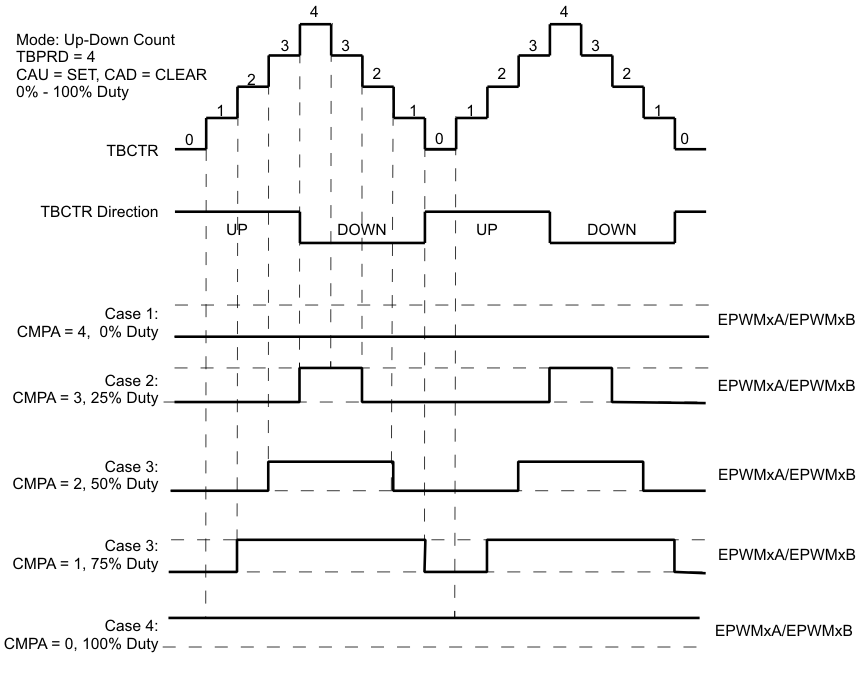 Figure 14-26 Up-Down Count Mode
Symmetrical Waveform
Figure 14-26 Up-Down Count Mode
Symmetrical WaveformThe PWM waveforms in Figure 14-27 through Figure 14-32 show some common action-qualifier configurations. Some conventions used in the figures and examples are as follows:
- TBPRD, CMPA, and CMPB refer to the value written in the respective registers. The active register, not the shadow register, is used by the hardware.
- CMPx, refers to either CMPA or CMPB.
- EPWMxA and EPWMxB refer to the output signals from ePWMx
- Up-Down means count-up-and count-down mode, Up means up-count mode and Down means down-count mode
- Sym = Symmetric, Asym = Asymmetric
